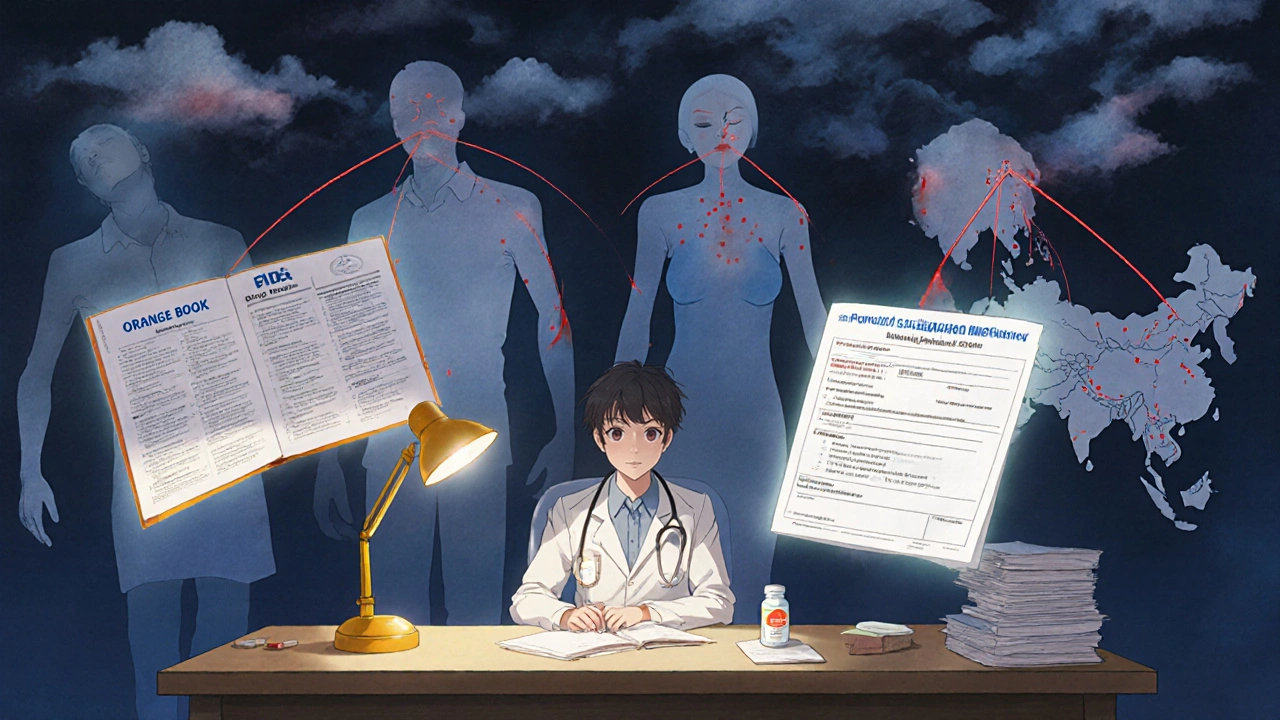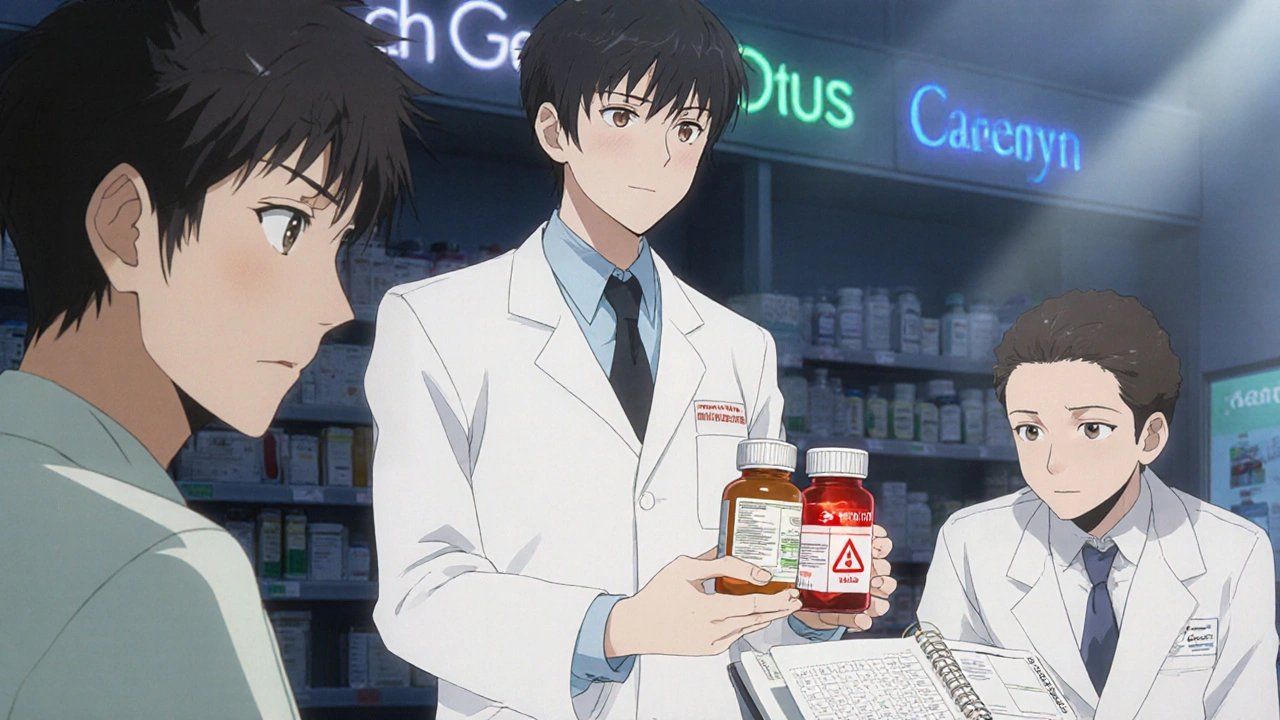Generic drugs save patients and the healthcare system billions every year. In the U.S., 90.7% of all prescriptions filled are generics - but not all generics are created equal. For most medications, switching from brand to generic is seamless and safe. But for some, even small differences in how the drug is made can lead to real harm. Pharmacists are often the last line of defense. Knowing when to pause, question, and flag a generic prescription isn’t optional - it’s essential.
When a Generic Isn’t Really the Same
The FDA requires generic drugs to have the same active ingredient, strength, dosage form, and route of administration as the brand-name version. They must also prove bioequivalence: meaning the body absorbs the drug at a rate and extent that falls within 80-125% of the brand. That sounds strict - and it is. But here’s the catch: 20% variation is still allowed. For most drugs, that’s fine. For others, it’s dangerous. Take levothyroxine, used to treat hypothyroidism. Even a 5% change in absorption can push a patient’s TSH levels out of range. One pharmacist in Sydney reported a case where switching from one generic manufacturer to another caused a patient’s TSH to jump from 2.1 to 8.7 in just six weeks. The patient was fatigued, gaining weight, and felt like they were back at square one. That’s not a coincidence - it’s a red flag. The FDA labels drugs with a therapeutic equivalence code. ‘AB’ means the generic is considered interchangeable. ‘BX’ means it’s not. If you see a BX rating, don’t assume it’s safe to substitute. Drugs like warfarin, phenytoin, digoxin, and tacrolimus are all BX-rated in some cases. These are narrow therapeutic index (NTI) drugs - where the difference between a therapeutic dose and a toxic one is razor-thin. For NTI drugs, the 20% bioequivalence window isn’t just theoretical. It’s clinically meaningful.Look-Alike, Sound-Alike: The Silent Killer
Another major issue isn’t about chemistry - it’s about confusion. Look-alike and sound-alike (LASA) names cause 14.3% of all generic medication errors, according to the Institute for Safe Medication Practices. Think oxycodone/acetaminophen vs. hydrocodone/acetaminophen. Or metoprolol tartrate vs. metoprolol succinate. One letter, one suffix - but completely different dosing, timing, and risks. Pharmacists see this daily. A patient walks in with a prescription for ‘Metoprolol 50mg.’ The label doesn’t say which formulation. The prescriber didn’t specify. The pharmacy’s system auto-fills the cheapest option. The patient gets the immediate-release version - but they were supposed to get the extended-release. They start feeling dizzy. Their heart rate drops. They end up in the ER. This isn’t rare. In a 2022 survey of 1,247 pharmacists, 63.2% reported encountering at least one problematic generic substitution in the past year. Nearly 30% said it led to patient harm. If you’re dispensing a drug with a similar name to another, pause. Double-check the prescription. Ask the prescriber. If in doubt, call the patient’s doctor. Don’t let convenience override safety.Extended-Release and Complex Formulations: The Hidden Trap
Not all generics are equal - especially when it comes to how the drug is delivered. Immediate-release tablets are relatively simple to copy. Extended-release, delayed-release, or transdermal patches? Much harder. In 2020, FDA testing found that 7.2% of generic extended-release opioids failed dissolution testing - meaning the drug didn’t release as expected. For a patient on a once-daily pain medication, that could mean sudden withdrawal symptoms or dangerous spikes in blood levels. The same issue has been seen with generic diltiazem CD. Between January 2021 and March 2022, 47 cases of therapeutic failure were reported after switching manufacturers. Patients reported chest pain, palpitations, and uncontrolled hypertension. Complex generics - like inhalers, injectables, or topical creams - make up just 1.2% of approved generics but account for 27% of the brand-name market. These are harder to replicate, and quality control varies. A 2022 FDA inspection found 243 quality control issues across generic manufacturing sites. Many were overseas. India and China accounted for nearly 90% of those problems. If a patient reports that a new generic ‘doesn’t work like the old one’ - especially for a chronic condition like asthma, epilepsy, or heart disease - don’t dismiss it. Document the manufacturer. Track the batch number. Report it. These aren’t isolated complaints. They’re early warnings.When to Flag: The Pharmacist’s Checklist
You don’t need to be a pharmacologist to spot trouble. Here’s what to look for:- NTI drugs: Levothyroxine, warfarin, phenytoin, digoxin, cyclosporine, tacrolimus. If the patient’s lab values change after a switch - flag it.
- Unexplained side effects: New nausea, dizziness, rash, or fatigue after switching generics? Especially if it happened right after a manufacturer change.
- Therapeutic failure: Blood pressure isn’t dropping. Seizures are returning. Cholesterol is climbing again. Check if the generic was changed in the last 2-4 weeks.
- Look-alike/sound-alike confusion: Always verify the exact drug name and formulation. Don’t rely on auto-fill.
- Complex formulations: Extended-release, transdermal, inhalers, injectables. If the patient says it ‘feels different,’ take it seriously.
- Multiple switches: Switching between three or more generic manufacturers in a year? That’s a red flag. Consistency matters.
What to Do When You Flag an Issue
Flagging isn’t enough. You need to act. First, document everything. Write down the drug name, manufacturer, lot number, and date dispensed. If the patient reports an issue, record their symptoms and timeline. This isn’t bureaucracy - it’s evidence. In 68.4% of therapeutic failure investigations, the key was tracing the problem back to a specific manufacturer. Second, talk to the prescriber. Don’t just say, ‘This generic didn’t work.’ Say, ‘The patient was stable on Brand X, switched to Generic Y, and now their TSH is 8.7. Can we go back to the previous version?’ Most prescribers will agree - especially if you’ve got data. Third, report it. Use the FDA’s MedWatch system. Submit a report through the Institute for Safe Medication Practices (ISMP). These reports are how the FDA finds patterns. Between 2020 and 2022, pharmacist-reported incidents increased by 18.3% after mandatory reporting laws were introduced in 15 states. Your report could prevent the next patient from getting hurt.
The Bigger Picture: Why This Matters
Generic drugs are vital. They make treatment possible for millions who couldn’t afford brand-name drugs. But safety can’t be sacrificed for cost. The FDA approves generics based on standards that work for most drugs - but not all. The system relies on pharmacists to be the eyes and ears on the ground. A 2023 Consumer Reports survey found 78.3% of patients are happy with generics. But 22.4% reported different side effects after switching manufacturers. That’s more than 1 in 5. These aren’t ‘just in their head.’ They’re real experiences. And if you ignore them, you’re ignoring patient safety. The FDA is stepping up. They’ve allocated $1.14 billion over five years to improve post-market surveillance. They’re testing more samples. They’re using AI to detect early warning signs. But none of that replaces the pharmacist who notices a patient’s symptoms don’t match the script.Final Thought: Trust Your Instinct
You’ve seen hundreds of prescriptions. You know what normal looks like. If something feels off - it probably is. Don’t wait for a guideline to tell you what to do. If a patient says, ‘This doesn’t feel right,’ listen. If a lab result suddenly looks wrong after a switch, investigate. If the same problem happens with two different patients on the same generic - speak up. Pharmacists don’t just fill prescriptions. You protect people. And sometimes, that means saying no - even when it’s cheaper, easier, or faster to say yes.Can I legally refuse to dispense a generic if I think it’s unsafe?
Yes, in most cases. Pharmacists have the professional and legal right to refuse to dispense a medication if they believe it poses a risk to patient safety. This includes refusing a generic substitution if you suspect it’s not therapeutically equivalent, especially for narrow therapeutic index (NTI) drugs. Many states require pharmacists to consult with the prescriber before substituting generics for NTI drugs. Always document your reasoning and notify the prescriber.
How do I check if a generic is AB-rated or BX-rated?
Use the FDA’s Orange Book, available online at fda.gov/orangebook. Search by brand name or active ingredient. Each entry shows the therapeutic equivalence code: ‘AB’ means the generic is approved as interchangeable; ‘BX’ means it’s not. If a drug has multiple generics, some may be AB-rated while others are BX. Always verify the specific manufacturer and formulation.
Are all generics made in the U.S. safe?
No. While U.S.-based manufacturers follow strict FDA oversight, over 80% of generic drug ingredients come from outside the U.S., primarily India and China. In 2022, the FDA found 1,247 quality-related issues during foreign inspections. The problem isn’t location - it’s manufacturing practices. Always check the manufacturer and report any consistent issues with a specific brand, regardless of where it’s made.
What should I do if a patient complains their generic doesn’t work like the old one?
Don’t dismiss it. Ask which manufacturer they were on before and which one they’re on now. Check if the drug is an NTI or extended-release product. Review their lab results or symptom history. Document everything. Contact the prescriber and suggest switching back to the previous version. If the problem persists across multiple patients with the same generic, report it to the FDA’s MedWatch system.
Do I need special training to identify problematic generics?
While not required everywhere, 32 U.S. states mandate 1-2 hours of generic drug education annually for license renewal. Even if your state doesn’t require it, staying informed is critical. Focus on NTI drugs, bioequivalence standards, and the FDA’s Orange Book. Resources from ASHP, APhA, and ISMP offer free continuing education modules. Your patients depend on your knowledge - not just your license.

